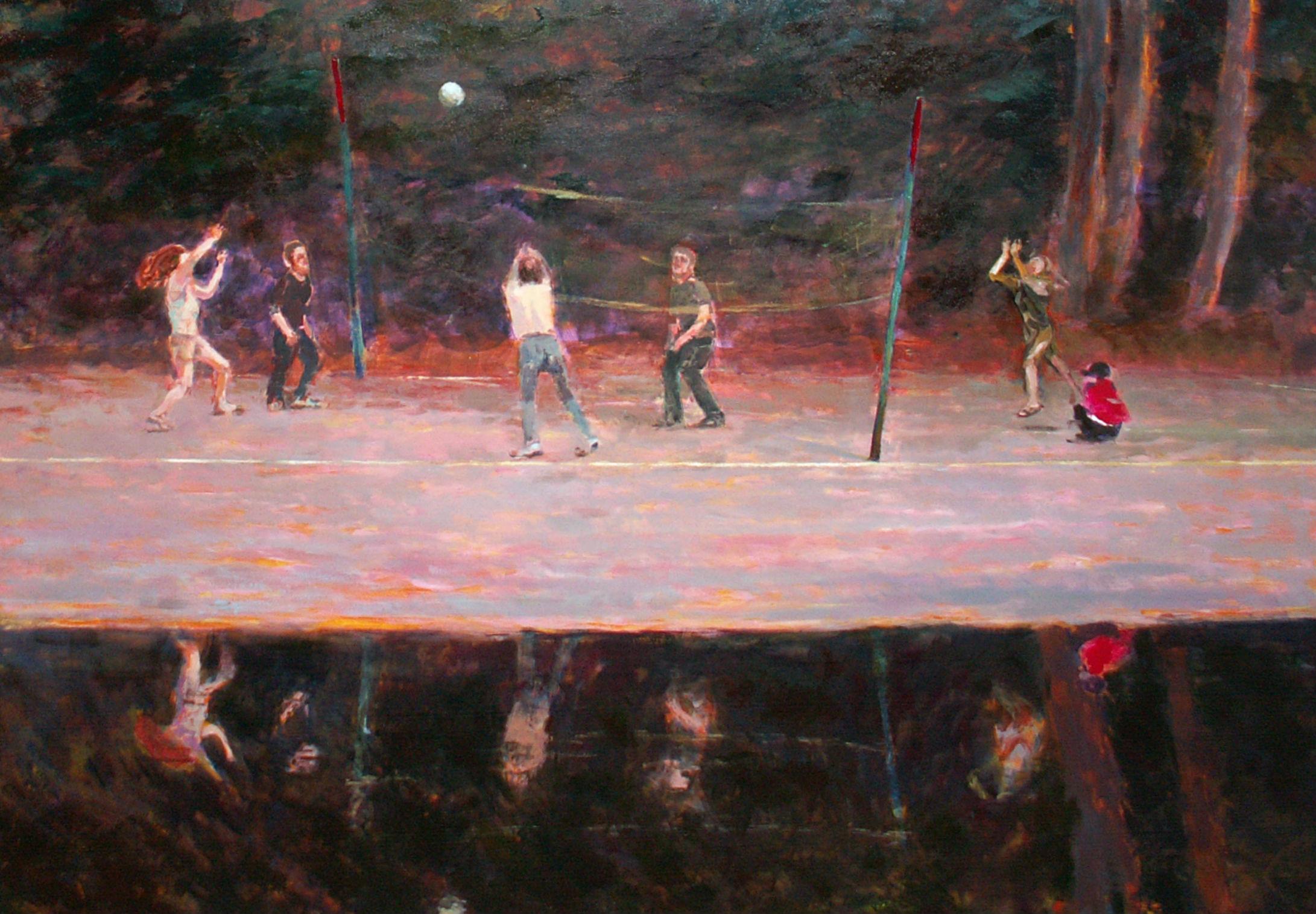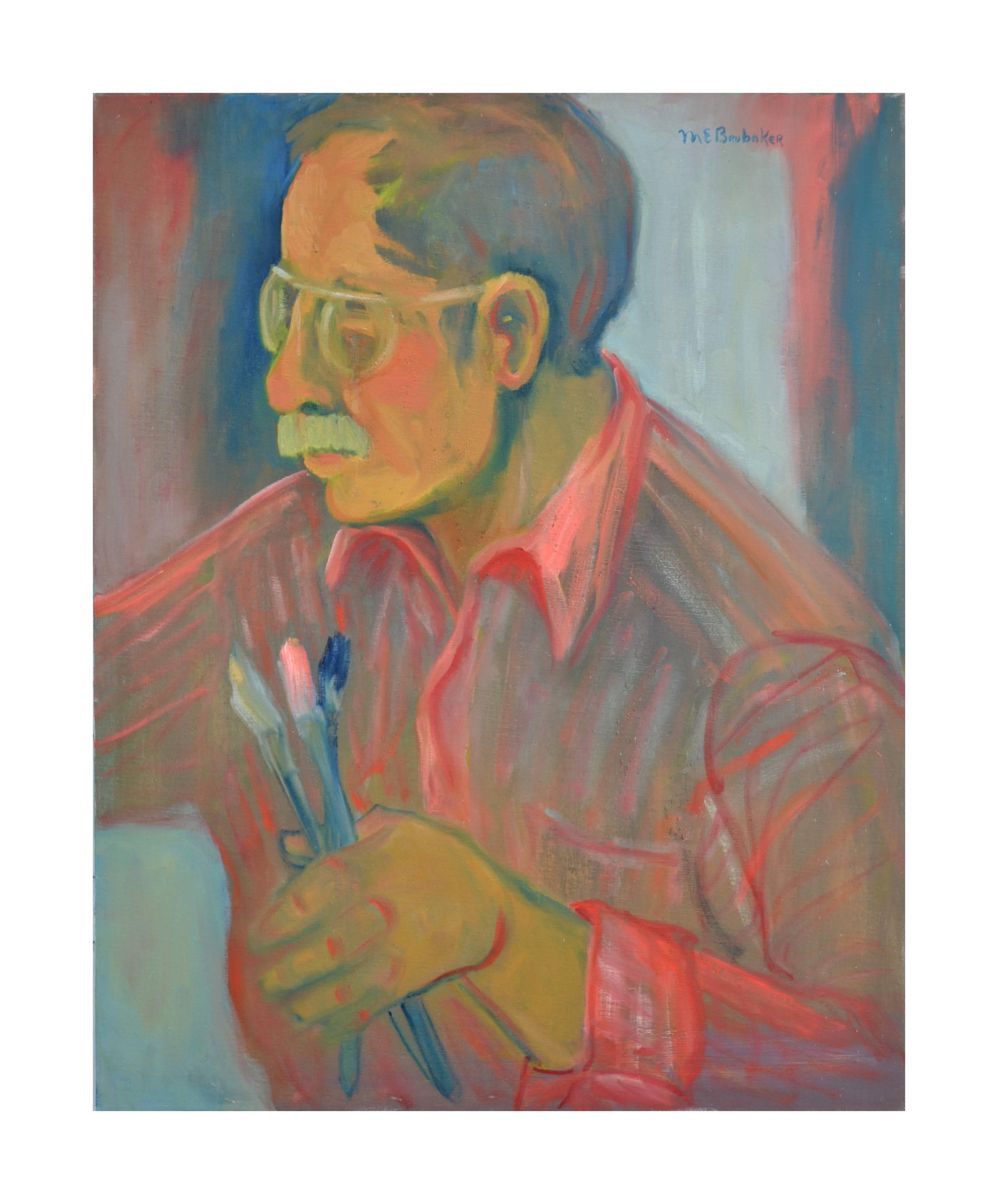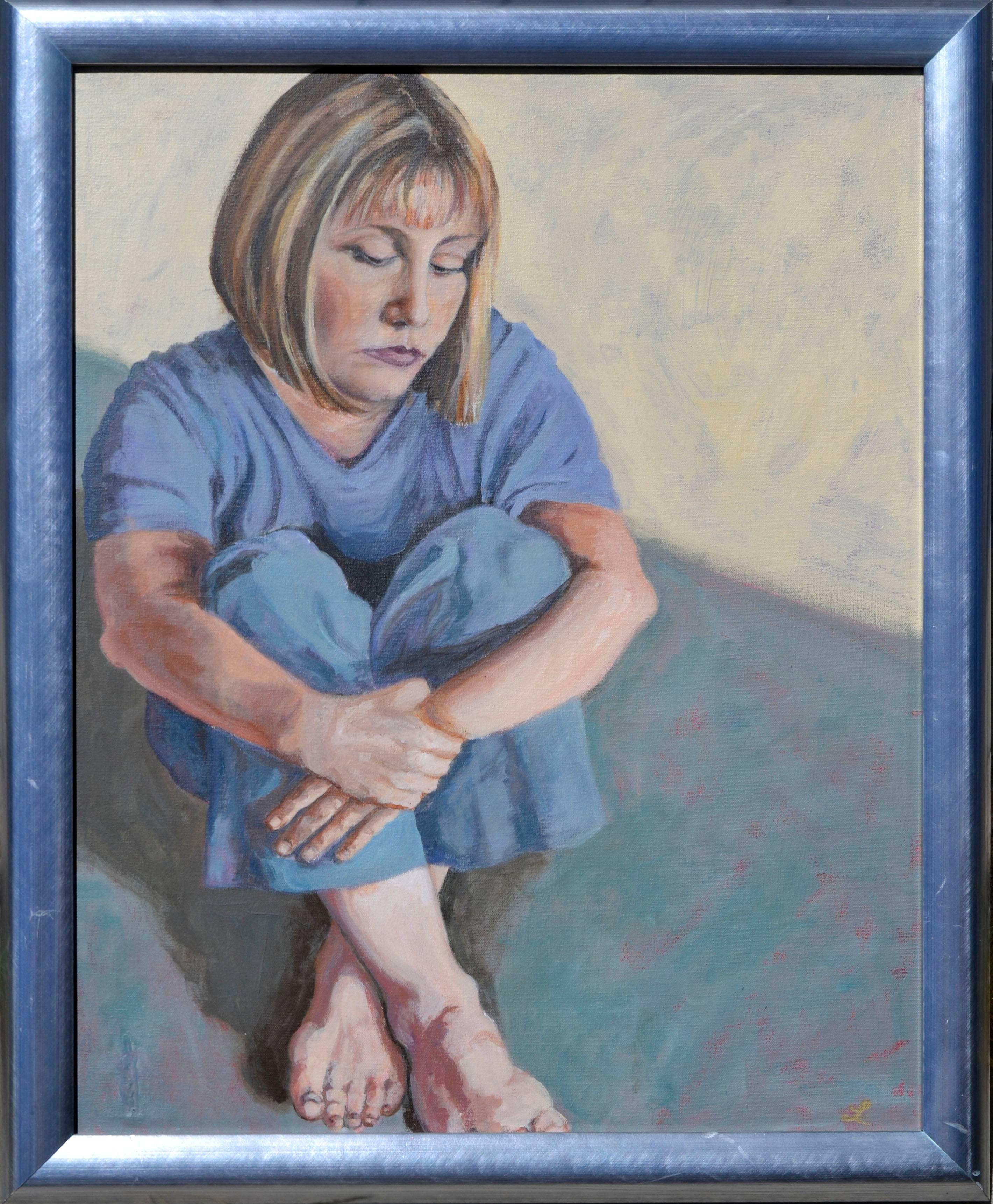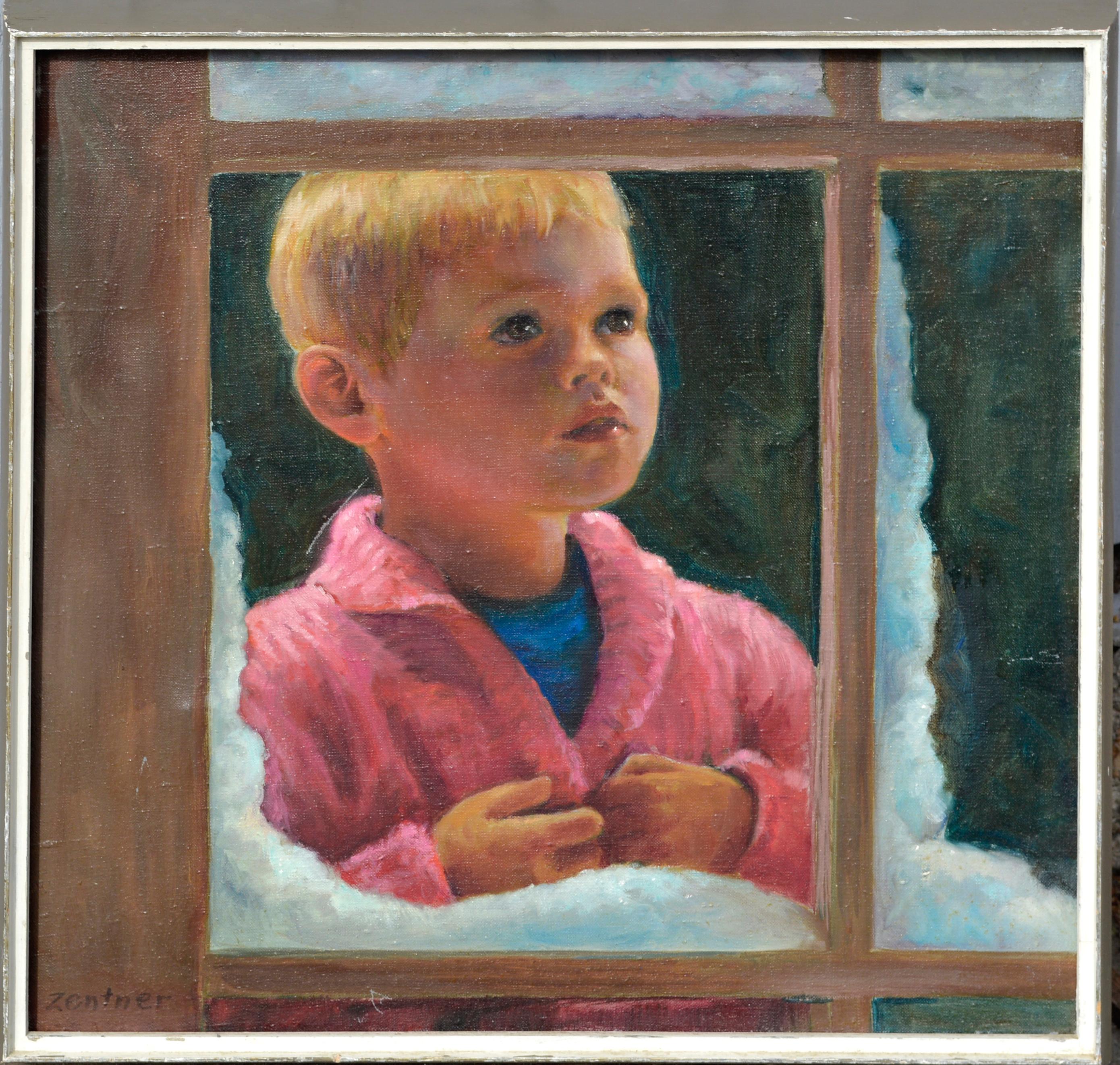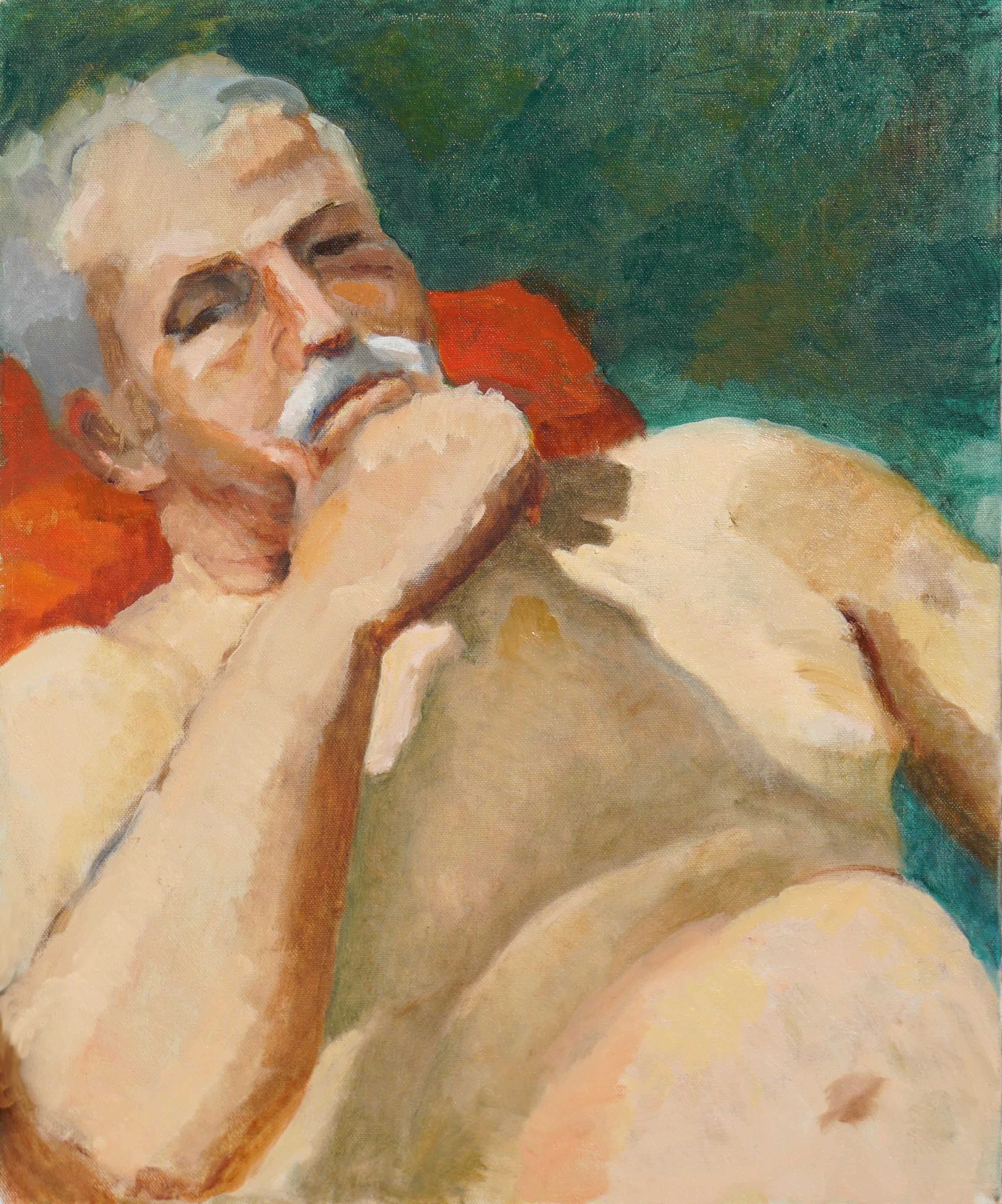Items Similar to Maternité by Henri Lebasque
Want more images or videos?
Request additional images or videos from the seller
1 of 9
Henri LebasqueMaternité by Henri Lebasque1912
1912
About the Item
Henri Lebasque
1865-1937 French
Maternité
(Maternity)
Oil on canvas
Signed “Lebasque” (lower left)
In this effusive oil on canvas, Henri Lebasque captures a contemplative scene of a young mother feeding an infant. Referential in subject to classic Renaissance scenes of the Madonna and child, Lebasque’s airy palette and en plain air setting in the French countryside bring a fresh vitality to art historical renderings of motherhood. Often called the “painter of joy and light,” Lebasque’s talent for creating bright canvases is on display in this original oil.
Henri Lebasque is remembered as a remarkable Post-Impressionist painter. Rooting himself in the Parisian art scene in the early 20th century, he exhibited in the influential Salon des Indépendants alongside artists like Georges Seurat, Paul Cézanne, Edouard Vuillard and Pierre Bonnard. He then went on to found the Salon d’Automne with Henri Matisse and other artist friends. His friendships with these artists and his visits to the south of France, initially encouraged by fellow painter Henri Manguin, influenced Lebasque’s rich use of color most associated with the Fauvist painters.
Exemplary of the colorful compositions that define his oeuvre, Maternité is pictured in the artist’s catalogue raisonné. Lebasque’s works can be found in prestigious museums collections worldwide, including the Musée d’Orsay in Paris, the National Museum of Western Art in Tokyo, the de Young in San Francisco, the Museo Thyssen in Madrid and the Pushkin State Museum of Fine Arts in Moscow.
Painted 1912
Unframed: 23 1/2 3/4“ high x 28 3/4” wide Framed: 36 2/5“ high x 31 1/8” wide x 2“ deep
Literature:
Denise Bazetoux, Henri Lebasque, Catalogue raisonné, Paris, 2008, vol. I, no. 558, illustrated p. 169.
Provenance:
Mme. Scheftel, Le Touquet.
Sale, Pillon, Calais, 30 September 2001, lot 134.
Sale, Sotheby’s, London, 25 June 2002, lot 227.Private Collection, North Palm Beach, FL.
M.S. Rau, New Orleans.
- Creator:Henri Lebasque (1865-1937, French)
- Creation Year:1912
- Dimensions:Height: 36.38 in (92.41 cm)Width: 31.13 in (79.08 cm)Depth: 2 in (5.08 cm)
- Medium:
- Movement & Style:
- Period:
- Condition:
- Gallery Location:New Orleans, LA
- Reference Number:
About the Seller
5.0
Vetted Seller
These experienced sellers undergo a comprehensive evaluation by our team of in-house experts.
Established in 1912
1stDibs seller since 2013
13 sales on 1stDibs
Typical response time: 5 hours
- ShippingRetrieving quote...Ships From: New Orleans, LA
- Return PolicyThis item cannot be returned.
More From This SellerView All
- Les deux soeurs by Federico ZandomeneghiBy Federico ZandomeneghiLocated in New Orleans, LAFederico Zandomeneghi 1841-1917 Italian Les deux soeurs (The two sisters) Signed and dated "Zandomeneghi 95" (lower left) Oil on canvas Two sisters enjoy a quiet moment in a rich green landscape in this intimate oil on canvas from Federico Zandomeneghi. An Italian painter by birth who became a fixture in the Parisian Impressionist scene, Zandomeneghi is best remembered for his sentimental and affectionate scenes of women in both domestic and public spheres. Zandomeneghi’s creative and technical prowess in composition is highlighted in this painting. The artist deftly frames the young pair in the lower register of the canvas, imbuing the work with a remarkably observational feel. The girls pensively gaze off to the right, lost in thought; Zandomeneghi allows the viewer to witness a natural moment of discussion and contemplation shared among the sisters. The soft palette employed by the artist gives the whole scene an atmospheric glow, with dappled rays of sunshine breaking through the lush foliage. Though the girls remain in the shaded areas of the landscape, Zandomeneghi’s skillful application of paint allows a brightness to remain nevertheless. Federico Zandomeneghi was born in Venice to a long line of neoclassical sculptors. As if created to be an artist, Zandomeneghi began his artistic education early, enrolling in the Accademia di Belle Arti in Venice at just 15 years old before transferring to the Academy of Fine Arts in Milan. By 1862, the artist had arrived in Florence, where he became fast acquaintances with several Italian artists dedicated to executing landscape paintings en plein air. Zandomeneghi embraced the spontaneity, seeking to bring unparalleled luminosity to his works. When Zandomeneghi arrived in Paris in 1874, he found kindred spirits...Category
19th Century Impressionist Figurative Paintings
MaterialsCanvas, Oil
- Christ as a Gardener by Edouard ManetBy Édouard ManetLocated in New Orleans, LAEdouard Manet 1832-1883 French Christ as a Gardener Oil on canvas Beloved for his invaluable role in the development of the Impressionist movement, Edouard Manet's artworks are foundational to the canon of art history. The revolutionary artist's rare religious works, while lesser-known, are some of the most intimate paintings he ever produced, offering insight into the artist’s fascination with the idea of humanity’s beautiful and transcendent relationship with suffering. Begun in 1856, Christ as a Gardener is one of his earliest renderings of Christ and offers a view into nascent motifs that would later define Manet’s monumental legacy. In the painting, Christ’s profile is turned toward the viewer, though his face is turned to the bottom left of the frame and his downturned eyes avert the viewer's gaze. His brown robes contrast the warm light of his halo and the dramatic sky behind him. As with all of Manet’s work, this image is rich with symbolism. A partial self-portrait, as seen in the similar facial hair and iconic appearance of a paintbrush-like garden tool, the painting renders the biblical scene of Mary Magdalene mistaking the risen Christ for a gardener with personal intimacy. As the biblical tale relays, when Mary Magdalene recognizes Christ, she reaches out to him; he replies, “Touch me not.” The highly charged relationship between the Christ figure and the viewer, standing in as Mary Magdalene, is further emphasized by Christ’s hand that appears to reach out for contact. Through this extension of touch, Christ’s presence is tangible, reminiscent of Michelangelo’s Creation of Adam in the Sistine Chapel. This intimate initiation of human connection directly contrasts Christ’s biblical words, “Touch me not.” Scholars have attributed this rejection, both in gaze and through words, to Manet’s conviction that Christ, as a human, embodied a spirit of renunciation and rejection of his earthly existence. Christ’s distant expression suggests a willingness to be elsewhere — an expression that Manet will later use in his most distinguished works of art. Manet would go on to expand his view of Christ as a timeless embodiment of absolute commitment and suffering with his monumental Salon paintings...Category
19th Century Impressionist Figurative Paintings
MaterialsOil, Canvas
- Dans le parc en automne, Paris (In the Park in Autumn, Paris)By Jean Francois RaffaëlliLocated in New Orleans, LAThis thoroughly modern Parisian scene was composed by the celebrated French painter Jean François Raffaëlli. The delicate oil captures a familiar subject from late 19th-century life in the city: a busy avenue at the edge of a park on a cool autumn day. Exploring the climate of the city, Raffaëlli's mature works capture the energy of the grand parks and boulevards of the new Paris that emerged at the turn of the century. His legacy documents the realities of urban life during his age, all chronicled in his distinctive brushwork and sophisticated palette. While Raffaëlli was never fully accepted as a member of the Impressionist group, his works display a similar affinity for capturing the transient moments of modern life. His figures exude a sense of being suspended in time, as though they are part of some subtle narrative that is both restless and harmonious. Perhaps more aligned with Naturalism than Impressionism, the visual effect of Raffaëlli's composition is one of carefully composed spontaneity that makes manifest the joie de vivre of the age. Raffaëlli was not the only artist of his era to devote his canvases to the urban landscape. Camille Pissarro, Claude Monet, Gustave Caillebotte and others composed significant works on the subject of the urban milieu. On the whole, it was an entirely new kind of painting, and it was largely influenced by the work of social engineer Baron Haussmann beginning in the 1850s. At the request of Emperor Napoleon III, Haussmann designed and carried out a large-scale urban renewal program, erecting landmarks and tree-lined thoroughfares throughout the city to create a unified and socially-centered urban aesthetic. The city became a glittering stage for modern advancements and bourgeois pleasure, which paved the way for a new kind of subject that was eagerly adopted by the Impressionists and artistic avant-garde. Born in Paris in 1850, Raffaëlli first studied theater and music before turning to painting in 1870. That same year, he submitted a landscape painting to the Salon and was accepted. Aside from just three months studying with the Academic great Jean-Léon Gérôme, Raffaëlli was self-trained, developing his own unique style that brought together Realism, Naturalism and Impressionism. While he managed to exhibit works at both the Salon and the Impressionist exhibitions...Category
Late 19th Century Impressionist Landscape Paintings
MaterialsOil, Board
- L’embarquement by Gaston La ToucheBy Gaston La ToucheLocated in New Orleans, LAGaston La Touche 1854 - 1913 French L’embarquement The Embarkment Signed "Gaston La Touche" (lower right) Oil on panel A fashionable group of merrymakers boards a rowboat at sundown in this oil on panel by renowned French painter Gaston La Touche. Softly lit and lushly detailed, the work represents the artist’s talent for capturing the gaiety of the Belle Époque. With its luminous coloring and feathery brushwork, this oil evokes the style and joie de vivre of the era rendered in La Touche’s distinctive, mature style. Fresh and airy, the work is a beautiful example of the artist’s skill at capturing the subtle qualities of light and color. Set against the plein air backdrop of a wooded pond awash in the soft glow of the golden hour, the scene reflects the influence of the Impressionists. The subject also recalls works by Manet, Monet and Renoir, who delighted in depictions of modern leisure among the expanding middle class. The scene is an informal one, and its unconventional cropping suggests that the viewer is invited to take a seat in the boat and join the group on their outing. Such relaxed, inviting scenes were remarkably popular among contemporary, modern audiences. However, La Touche's style is singular, possessing an element of fantasy and romance that set him apart from the Impressionists. Gaston La Touche was born in St. Cloud, outside of Paris, in 1854, and he showed a keen interest in art from a young age. At ten years old, he began taking private art instruction, which lasted until 1870, when his family was forced to flee to Normandy amid the Franco-Prussian War. This was the only formal art training La Touche would ever receive. Despite his lack of Academy training, he made his debut at the Paris Salon of 1875 with a sculptural medallion and etchings, and he exhibited his first painting at the Salon of 1881. Although he began his career painting dark-toned realist compositions, by 1890, his style had shifted to what would become his signature — a lighter, brighter, idealistic society world. The artist was associated with practically all of the most influential artists and thinkers of late 19th century France, including Édouard Manet, Edgar Degas, Émile Zola, who frequently met at the legendary Cafe de la Nouvelle Athenes to share their thoughts on modern society. In 1900, he was named a Chevalier of the Legion d'Honneur and an Officer in 1909. Additionally, he was well-decorated at the grand...Category
Late 19th Century Impressionist Figurative Paintings
MaterialsOil, Panel
- TaroudantLocated in New Orleans, LASigned, inscribed and dated "R. Pinatel / Taroudant / 1926" (lower right) Oil on panel A stunning ode to the Moroccan landscape, this oil on panel was composed by the French Orientalist painter Raphaël Pinatel, whose lively works adeptly translated the romanticism of the East for a Western audience. The present work, which captures a market in Taroudant, a city in southeastern Morocco, exemplifies the artist’s distinctive approach as he brilliantly translates the energy and atmosphere of the desert city. Pinatel’s style is impressionistic in his brushwork and handling of light and atmosphere. In the present work, he brilliantly captures the effects of the direct desert sun...Category
Early 20th Century Impressionist Landscape Paintings
MaterialsOil, Panel
- Après le bain (After the bath)By Pierre Auguste RenoirLocated in New Orleans, LAFor Pierre-Auguste Renoir, Impressionism's pre-eminent figure painter, depicting the nude was an exercise in bringing the canvas to life. He once said, “I look at a nude, I see myriads of minuscule shades. I have to find those which will make the flesh on my canvas come to life and resonate.” This compelling portrait by Renoir entitled Après le bain presents the nude figure of a woman in a serene, private moment, absorbed in the task of drying herself after a bath. The artist’s mastery of light and shading is incredible, achieving a sense of vitality in this otherwise ordinary scene. Renoir is celebrated for his figural work, especially his Rubenesque female nudes, however, it was not until the artist was in his forties that he depicted the nude with any frequency. In 1881, Renoir traveled to Italy, where he studied the works of the Renaissance masters and the ancient art of Pompeii and Rome. Upon his return to France, the nude became his favored subject, and he used the motif to combine the spontaneity of Impressionism with the solid modeling of classical painting. Renoir’s medium here, sanguine, a reddish-brown chalk, was used extensively in the Renaissance by Leonardo (who employed it in his sketches for the Last Supper), Michelangelo and Raphael. Its warm hue lends itself well to depicting flesh, and the chalk drawing allows for a greater focus on line, form and texture in a departure from the aspects of color and light that so often preoccupied the Impressionists. Après le bain conveys the impression of arrested motion with perfect naturalness, deftly capturing the moment before the elegant lines of the sitter's form change position. The sitter is almost certainly Gabrielle Renard, the nanny to Renoir’s children and a frequent model for the artist. Gabrielle was the cousin of Renoir’s wife, Aline, and came to Montmartre to work for the family at the age of 16. She developed a strong bond with the family and became a favorite subject for Renoir, appearing in several of his most important works, including his 1911 Gabrielle with a Rose (Musée d'Orsay). When Renoir began to suffer from severe rheumatoid arthritis that would eventually leave him unable to walk and scarcely able to grasp a paintbrush, it was Gabrielle that would assist the artist by positioning the paintbrush between his crippled fingers. Born in Limoges, France in 1841, Renoir began his career as an apprentice to a painter of porcelain wares. He later moved to Paris at the age of 21, enrolling at the prestigious École des Beaux-Arts. It was here, while studying under Charles Gleyre, that Renoir attained a tremendous appreciation for the academic style of painting, a quality that would last throughout his career. This was also when he met Claude Monet and several other classmates, with whom he would later form the Impressionists. Working closely with Monet, Renoir began experimenting with the portrayal of light and its effect on his canvases. The youngest member of the Impressionist movement, an astute Renoir recognized how a subject was constantly changing due to the dynamic effects of light on color. Relying heavily upon his academic training that focused on composition, lines and descriptive details, Renoir distinguished himself among his contemporaries. His intuitive use of color and expansive brushstroke, along with acute attention to his subject, have placed him among the finest painters in history. This work is accompanied by a certificate of authenticity and will be included in the forthcoming catalogue raisonné of the work of Pierre-Auguste Renoir from the Wildenstein Plattner Institute. Circa 1898 Canvas: 43 1/2" high x 35 1/2" wide Frame: 57 3/4" high x 49 1/4" wide Provenance: Galerie Durand-Ruel, Paris (acquired from the artist on January 25, 1899) J. Pereire Collection, France (1966) Sam Salz, New York (before 1981) Claus Virch, Paris French Compagny, Inc., New York Larry Silverstein, New York (circa January 1987) Le Clos de Sierne Gallery, Geneva Galerie Heyram, Paris (October 1987) Francis Gross M.S. Rau, New Orleans Literature: B. Schneider, Renoir, Berlin, 1957, p. 95 (illustrated in color, p. 83) M. Gauthier, Renoir, Paris, 1958, p. 83 (illustrated in color; erroneously dated '1916' and titled 'Woman in her toilet') F. Fosca, Renoir, L'homme et son obra, Paris, 1961, p. 280 (illustrated, p. 95; erroneously dated 'about 1890' and titled 'After the Bath...Category
19th Century Impressionist Nude Paintings
MaterialsCanvas, Paper, Chalk
You May Also Like
- Volleyball - XXI Century Contemporary Figurative Oil Painting, Sport, LandscapeBy Dorota Zych-CharaziakLocated in Warsaw, PLDorota Zych-Charaziak is a Polish artist born in 1964 in Warsaw. She studied at the Faculty of Painting at the Academy of Fine Arts of Poland, in the atelier of Professor Tadeusz Dominik...Category
2010s Impressionist Figurative Paintings
MaterialsCanvas, Oil
- Vintage Abstract Expressionist -- An Artist and His ToolsBy Molly E. BrubakerLocated in Soquel, CAWonderful abstract expressionist figurative of a painter at work, deeply focused on his subject is captured by California artist Molly E. Brubaker (American, 1922-2000). Unframed. Im...Category
1970s American Impressionist Figurative Paintings
MaterialsCanvas, Oil
- Lise, a Self Portrait of the ArtistBy Lise Lang CrowleyLocated in Soquel, CASelf-portrait of the artist, in a pensive seated pose, by Lise Lang Crowley (American, 20th century). Signed "L" lower right and signed "Lise Lang Crowley" on verso. Presented in a r...Category
1990s American Impressionist Portrait Paintings
MaterialsCanvas, Oil
- Montigny-sur-LoingLocated in New York, NYDated, signed, and inscribed lower left: 1876 WILL. • H • LOW MONTIGNY sur LoingCategory
Late 19th Century American Impressionist Figurative Paintings
MaterialsCanvas, Oil
- "I See a Robin" - Portrait of a Boy in WinterBy Veon ZentnerLocated in Soquel, CA"I See a Robin," a figurative oil painting of a boy in a window by Veon Zentner (American, 20th Century). Presented in a rustic wooden frame. Signed "Zentner" lower left. Titled "I S...Category
1990s American Impressionist Figurative Paintings
MaterialsCanvas, Oil
- Vintage Nude Study -- Reclining MaleBy Patricia Emrich GillfillanLocated in Soquel, CAWonderful vintage reclining male nude study by Patricia E. Gillfillan (American, 1924-2016), c.1980s. From a collection of her works. Unsigned. Unframed...Category
1980s American Impressionist Figurative Paintings
MaterialsCanvas, Oil
Recently Viewed
View AllMore Ways To Browse
Antique Art Sale
June Young
Henri Matisse Signed
Sothebys Antique
Henri Matisse Original
Antique Artist Palette
Antique Artists Palette
Henri Matisse Framed
Oeuvre Antique
Henri 2
D Fl
Fine Art Parisian Painting
Antique Friendship
De Orsay
Antique Western Signs
Mother A D Child
Souther Renaissance
George Inness Paintings For Sale
